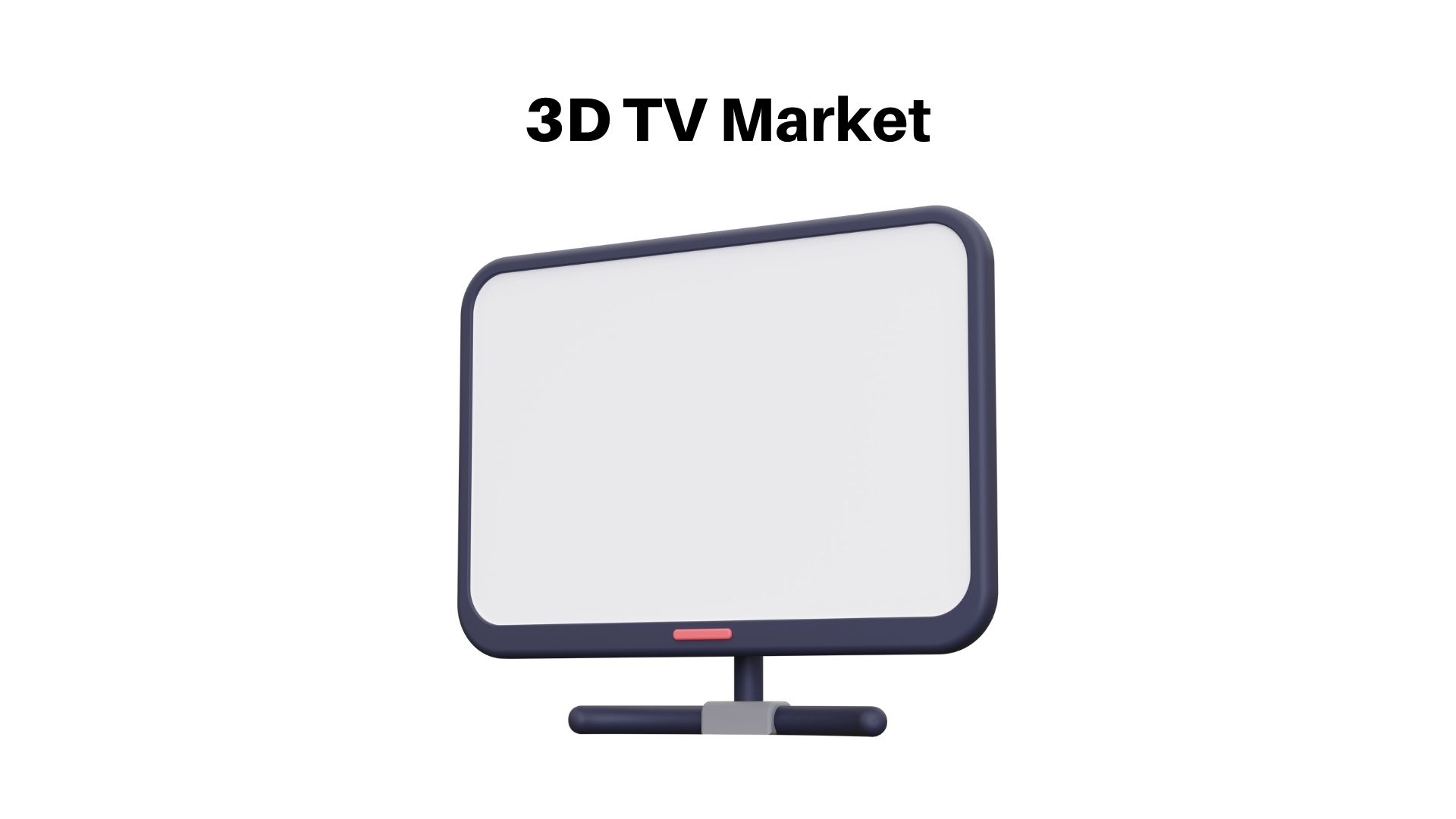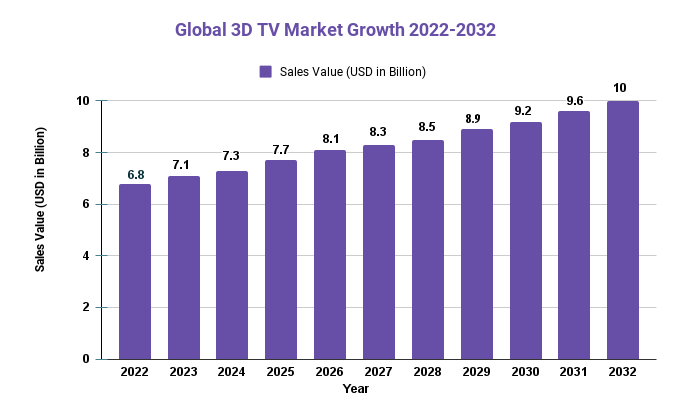3D TV Market Size USD 10.0 Bn by 2032| at a CAGR 4.0%

Page Contents
Market Overview
Published Via 11Press: The 3D TV market refers to televisions that utilize advanced technologies for images that create a three-dimensional effect. Although initially anticipated to grow rapidly, the 3D TV market has encountered challenges due to high costs, lack of content for 3D viewers, and availability of alternative technologies like virtual reality or augmented reality. According to industry analysts, global 3D TV Market size will increase from USD 6.8 billion in 2022 to USD 10.0 billion by 2032 at an annual compound growth rate (CAGR) of 4.0% between 2032.
In recent years, the 3D TV market experienced a decline due to factors such as limited content availability and lack of consumer interest. Nonetheless, forecasts still predicted moderate growth over the coming years, driven by advances in technology and increasing demand for high-quality viewing experiences. One major trend within this space was an increasing shift towards passive 3D technology which uses less expensive glasses but produces brighter and clearer images; this trend was expected to gain ground among customers and become more widely adopted within the industry.
Geographically, North America and Europe were expected to remain the primary markets for 3D TVs; however, Asia-Pacific was expected to experience rapid growth due to rising disposable income and demand for high-end electronic products in this region. Key players in this space included Samsung Electronics, LG Electronics, Sony Corporation, Panasonic Corporation, and Toshiba Corporation among others. These companies invested heavily in research and development to enhance their product offerings while remaining competitive within the market.
Request For Sample Report Here: https://market.us/report/3d-tv-market/request-sample/

Key Takeaways
- The 3D TV market has experienced challenges due to high costs, lack of content, and competition from alternative technologies.
- Despite these setbacks, certain niche markets such as gaming or sports broadcasting continue to use 3D TV technology.
- The Asia-Pacific region is expected to dominate the 3D TV market owing to its large population, growing middle class, and growing appetite for advanced technologies.
Regional Snapshot
- North America: The North American market for 3D TVs has experienced a decline in recent years due to the challenges mentioned. Nonetheless, certain niche markets such as sports broadcasting and gaming still utilize 3D TV technology.
- Europe: Similar to North America, the European market for 3D TVs has experienced a decline due to high costs and an absence of relevant content.
- Asia-Pacific: Asia-Pacific is expected to lead the 3D TV market due to its large population, growing middle class, and increasing appetite for cutting-edge technologies.
Drivers
- Niche markets such as gaming and sports broadcasting continue to drive demand for 3D TVs.
- Technological advances like glasses-free 3D displays could help revive this market.
- Furthermore, emerging technologies in emerging regions such as Asia-Pacific may spur demand for 3D TVs.
Restraints
- The high costs of 3D TVs have made them unaffordable for many consumers.
- A lack of 3D content has further limited their appeal among mainstream viewers.
- Competition from alternative technologies such as virtual reality and augmented reality also has contributed to decreasing demand for 3D TVs.
Opportunities
- Growing Demand for 3D Content: With the rising popularity of 3D movies and video games, there is a great opportunity for 3D TV manufacturers to capture this market share.
- Technological Advances: The development of glasses-free 3D technology presents manufacturers with an exciting opportunity to offer consumers a more immersive viewing experience.
- Increased Adoption of 4K and 8K Resolution: As consumers demand higher resolution displays, 3D TV manufacturers can integrate 3D technology into these high-resolution screens for an enhanced viewing experience.
View Detailed TOC of the Report: https://market.us/report/3d-tv-market/table-of-content/
Challenges
- Limited Content Availability: Despite the growing interest in 3D content, there remains a limited selection available to consumers.
- High Cost: 3D TV technology remains relatively expensive, making it difficult for manufacturers to reach a wider audience.
- Limited Consumer Interest: Despite the initial excitement around 3D TV technology, many consumers have yet to express sustained enthusiasm for it.
Recent Developments
- Glasses-Free 3D Technology: Manufacturers are increasingly investing in glasses-free 3D technology, which eliminates the need for 3D glasses and provides a more natural viewing experience.
- 8K Resolution: As 8K resolution displays become increasingly popular, manufacturers are now incorporating 3D technology into these displays for a more immersive viewing experience.
- Virtual Reality: Virtual reality offers 3D TV manufacturers an exciting chance to create a more immersive and interactive viewing experience.
Key Market Segments
Type
- Non-glass Free
- Glass-Free
Application
- Household
- Commercial
Key Market Players
- LG Corp
- Samsung
- Sony Corp
- Sharp Corp
- Toshiba Corp
- Vizio
- Videocon Industries Ltd
- Hisense
- TCL
Report Scope
| Report Attribute | Details |
| The market size value in 2022 | USD 6.8 Bn |
| Revenue forecast by 2032 | USD 10.0 Bn |
| Growth Rate | CAGR Of 4.0% |
| Regions Covered | North America, Europe, Asia Pacific, Latin America, and Middle East & Africa, and Rest of the World |
| Historical Years | 2017-2022 |
| Base Year | 2022 |
| Estimated Year | 2023 |
| Short-Term Projection Year | 2028 |
| Long-Term Projected Year | 2032 |
Frequently Asked Questions
Q: Is 3D TV technology still relevant?
A: While the initial excitement around 3D TV technology has worn off, there remains a market for them – particularly in gaming and other interactive applications.
Q: Do I Need Special Glasses to Watch 3D TV?
Traditional 3D TV requires the use of special glasses to create the effect, however, newer glasses-free 3D technologies are becoming more prevalent.
Q: Is there a lot of 3D content available to watch on 3D TVs?
A: While some 3D content is accessible, it's still relatively limited compared to traditional 2D options.
Q: Are 3D TVs more expensive than traditional televisions?
A: Yes, 3D TVs tend to be pricier due to the additional technology needed to achieve the 3D effect.
Q: Can I watch regular 2D content on a 3D TV?
A: Absolutely, 3D televisions can also be utilized for watching regular 2D programming.
The team behind market.us, marketresearch.biz, market.biz and more. Our purpose is to keep our customers ahead of the game with regard to the markets. They may fluctuate up or down, but we will help you to stay ahead of the curve in these market fluctuations. Our consistent growth and ability to deliver in-depth analyses and market insight has engaged genuine market players. They have faith in us to offer the data and information they require to make balanced and decisive marketing decisions.



